Critical Analysis: Linguistic Politeness in EFL and CLIL Indirectness
VerifiedAdded on 2023/04/04
|8
|1674
|252
Essay
AI Summary
This assignment contains two argumentative essays. The first essay critically analyzes how the linguistic politeness model is expressed through indirect strategies in English as a Foreign Language (EFL) and Content and Language Integrated Learning (CLIL) contexts, highlighting the challenges and importance of communicative competence in second language learning. The second essay discusses Winterson's novel 'Oranges Are Not the Only Fruit' as a pragmatist text and examines how pragmatic strategies facilitated its adaptation into a television series, focusing on its cultural production and challenge to societal norms regarding lesbian coming-of-age stories. Both essays provide critical insights and arguments supported by relevant studies and literary analysis.

Running head: ARGUMENTATIVE ESSAYS 1
Argumentative essays
Name
Institution
Argumentative essays
Name
Institution
Paraphrase This Document
Need a fresh take? Get an instant paraphrase of this document with our AI Paraphraser
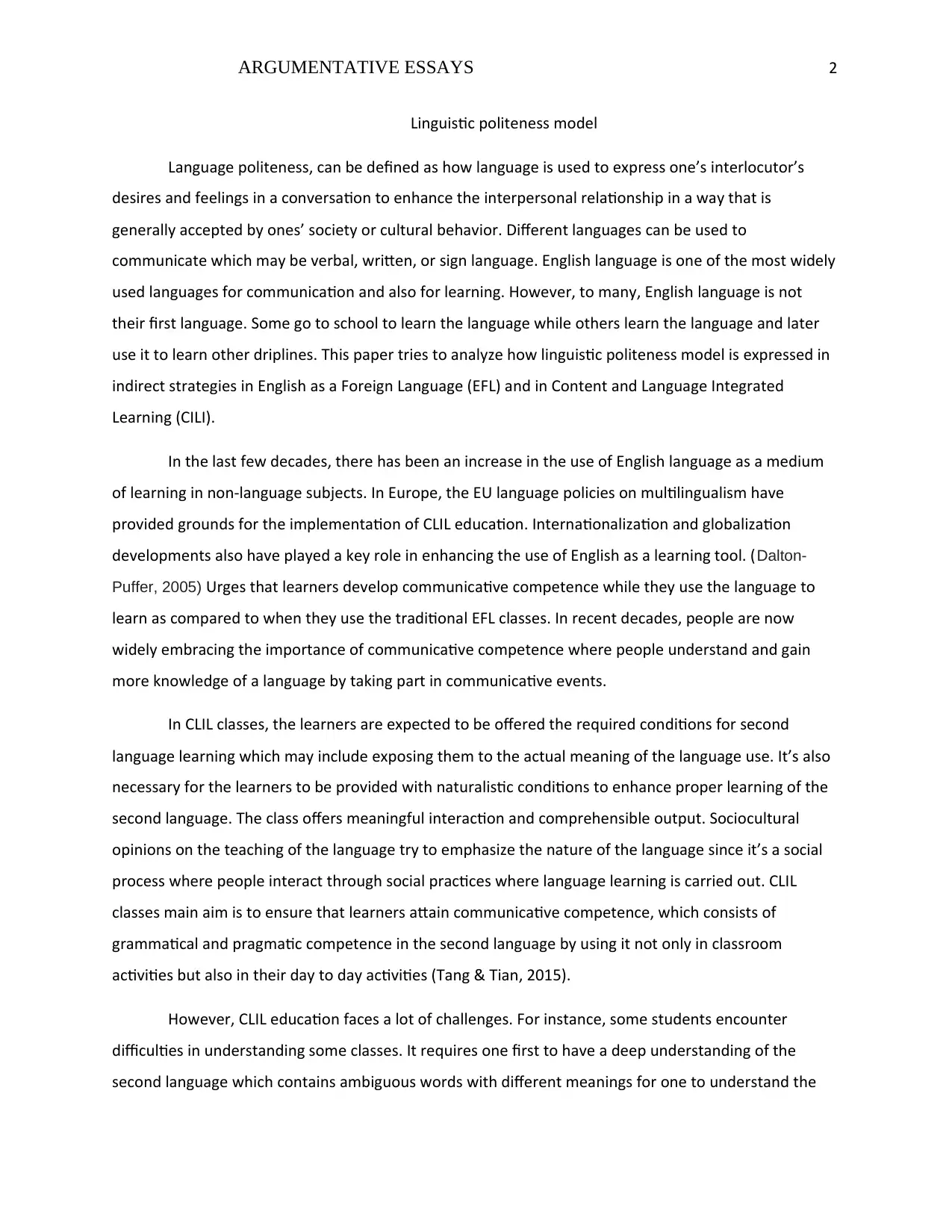
ARGUMENTATIVE ESSAYS 2
Linguistic politeness model
Language politeness, can be defined as how language is used to express one’s interlocutor’s
desires and feelings in a conversation to enhance the interpersonal relationship in a way that is
generally accepted by ones’ society or cultural behavior. Different languages can be used to
communicate which may be verbal, written, or sign language. English language is one of the most widely
used languages for communication and also for learning. However, to many, English language is not
their first language. Some go to school to learn the language while others learn the language and later
use it to learn other driplines. This paper tries to analyze how linguistic politeness model is expressed in
indirect strategies in English as a Foreign Language (EFL) and in Content and Language Integrated
Learning (CILI).
In the last few decades, there has been an increase in the use of English language as a medium
of learning in non-language subjects. In Europe, the EU language policies on multilingualism have
provided grounds for the implementation of CLIL education. Internationalization and globalization
developments also have played a key role in enhancing the use of English as a learning tool. (Dalton-
Puffer, 2005) Urges that learners develop communicative competence while they use the language to
learn as compared to when they use the traditional EFL classes. In recent decades, people are now
widely embracing the importance of communicative competence where people understand and gain
more knowledge of a language by taking part in communicative events.
In CLIL classes, the learners are expected to be offered the required conditions for second
language learning which may include exposing them to the actual meaning of the language use. It’s also
necessary for the learners to be provided with naturalistic conditions to enhance proper learning of the
second language. The class offers meaningful interaction and comprehensible output. Sociocultural
opinions on the teaching of the language try to emphasize the nature of the language since it’s a social
process where people interact through social practices where language learning is carried out. CLIL
classes main aim is to ensure that learners attain communicative competence, which consists of
grammatical and pragmatic competence in the second language by using it not only in classroom
activities but also in their day to day activities (Tang & Tian, 2015).
However, CLIL education faces a lot of challenges. For instance, some students encounter
difficulties in understanding some classes. It requires one first to have a deep understanding of the
second language which contains ambiguous words with different meanings for one to understand the
Linguistic politeness model
Language politeness, can be defined as how language is used to express one’s interlocutor’s
desires and feelings in a conversation to enhance the interpersonal relationship in a way that is
generally accepted by ones’ society or cultural behavior. Different languages can be used to
communicate which may be verbal, written, or sign language. English language is one of the most widely
used languages for communication and also for learning. However, to many, English language is not
their first language. Some go to school to learn the language while others learn the language and later
use it to learn other driplines. This paper tries to analyze how linguistic politeness model is expressed in
indirect strategies in English as a Foreign Language (EFL) and in Content and Language Integrated
Learning (CILI).
In the last few decades, there has been an increase in the use of English language as a medium
of learning in non-language subjects. In Europe, the EU language policies on multilingualism have
provided grounds for the implementation of CLIL education. Internationalization and globalization
developments also have played a key role in enhancing the use of English as a learning tool. (Dalton-
Puffer, 2005) Urges that learners develop communicative competence while they use the language to
learn as compared to when they use the traditional EFL classes. In recent decades, people are now
widely embracing the importance of communicative competence where people understand and gain
more knowledge of a language by taking part in communicative events.
In CLIL classes, the learners are expected to be offered the required conditions for second
language learning which may include exposing them to the actual meaning of the language use. It’s also
necessary for the learners to be provided with naturalistic conditions to enhance proper learning of the
second language. The class offers meaningful interaction and comprehensible output. Sociocultural
opinions on the teaching of the language try to emphasize the nature of the language since it’s a social
process where people interact through social practices where language learning is carried out. CLIL
classes main aim is to ensure that learners attain communicative competence, which consists of
grammatical and pragmatic competence in the second language by using it not only in classroom
activities but also in their day to day activities (Tang & Tian, 2015).
However, CLIL education faces a lot of challenges. For instance, some students encounter
difficulties in understanding some classes. It requires one first to have a deep understanding of the
second language which contains ambiguous words with different meanings for one to understand the
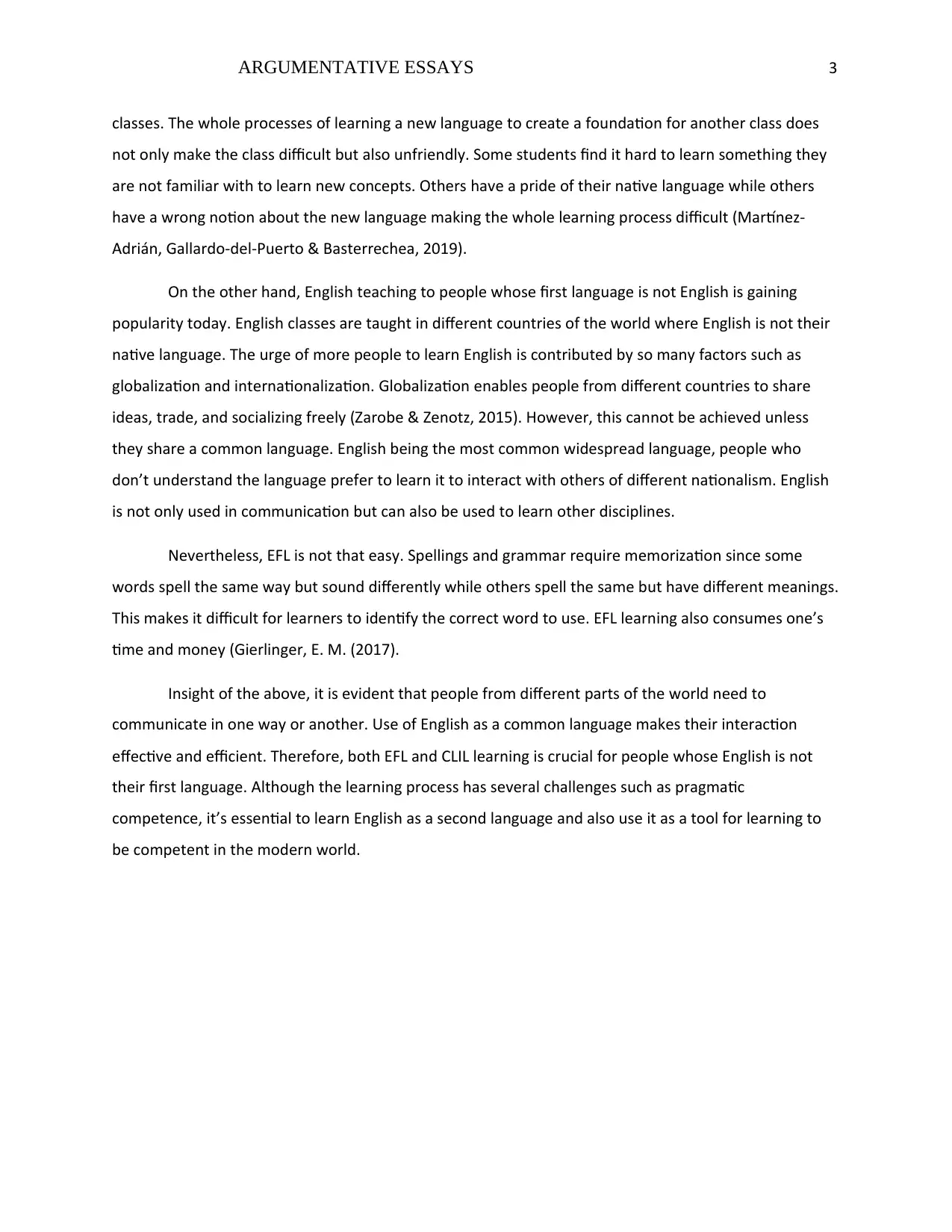
ARGUMENTATIVE ESSAYS 3
classes. The whole processes of learning a new language to create a foundation for another class does
not only make the class difficult but also unfriendly. Some students find it hard to learn something they
are not familiar with to learn new concepts. Others have a pride of their native language while others
have a wrong notion about the new language making the whole learning process difficult (Martínez-
Adrián, Gallardo-del-Puerto & Basterrechea, 2019).
On the other hand, English teaching to people whose first language is not English is gaining
popularity today. English classes are taught in different countries of the world where English is not their
native language. The urge of more people to learn English is contributed by so many factors such as
globalization and internationalization. Globalization enables people from different countries to share
ideas, trade, and socializing freely (Zarobe & Zenotz, 2015). However, this cannot be achieved unless
they share a common language. English being the most common widespread language, people who
don’t understand the language prefer to learn it to interact with others of different nationalism. English
is not only used in communication but can also be used to learn other disciplines.
Nevertheless, EFL is not that easy. Spellings and grammar require memorization since some
words spell the same way but sound differently while others spell the same but have different meanings.
This makes it difficult for learners to identify the correct word to use. EFL learning also consumes one’s
time and money (Gierlinger, E. M. (2017).
Insight of the above, it is evident that people from different parts of the world need to
communicate in one way or another. Use of English as a common language makes their interaction
effective and efficient. Therefore, both EFL and CLIL learning is crucial for people whose English is not
their first language. Although the learning process has several challenges such as pragmatic
competence, it’s essential to learn English as a second language and also use it as a tool for learning to
be competent in the modern world.
classes. The whole processes of learning a new language to create a foundation for another class does
not only make the class difficult but also unfriendly. Some students find it hard to learn something they
are not familiar with to learn new concepts. Others have a pride of their native language while others
have a wrong notion about the new language making the whole learning process difficult (Martínez-
Adrián, Gallardo-del-Puerto & Basterrechea, 2019).
On the other hand, English teaching to people whose first language is not English is gaining
popularity today. English classes are taught in different countries of the world where English is not their
native language. The urge of more people to learn English is contributed by so many factors such as
globalization and internationalization. Globalization enables people from different countries to share
ideas, trade, and socializing freely (Zarobe & Zenotz, 2015). However, this cannot be achieved unless
they share a common language. English being the most common widespread language, people who
don’t understand the language prefer to learn it to interact with others of different nationalism. English
is not only used in communication but can also be used to learn other disciplines.
Nevertheless, EFL is not that easy. Spellings and grammar require memorization since some
words spell the same way but sound differently while others spell the same but have different meanings.
This makes it difficult for learners to identify the correct word to use. EFL learning also consumes one’s
time and money (Gierlinger, E. M. (2017).
Insight of the above, it is evident that people from different parts of the world need to
communicate in one way or another. Use of English as a common language makes their interaction
effective and efficient. Therefore, both EFL and CLIL learning is crucial for people whose English is not
their first language. Although the learning process has several challenges such as pragmatic
competence, it’s essential to learn English as a second language and also use it as a tool for learning to
be competent in the modern world.
⊘ This is a preview!⊘
Do you want full access?
Subscribe today to unlock all pages.

Trusted by 1+ million students worldwide
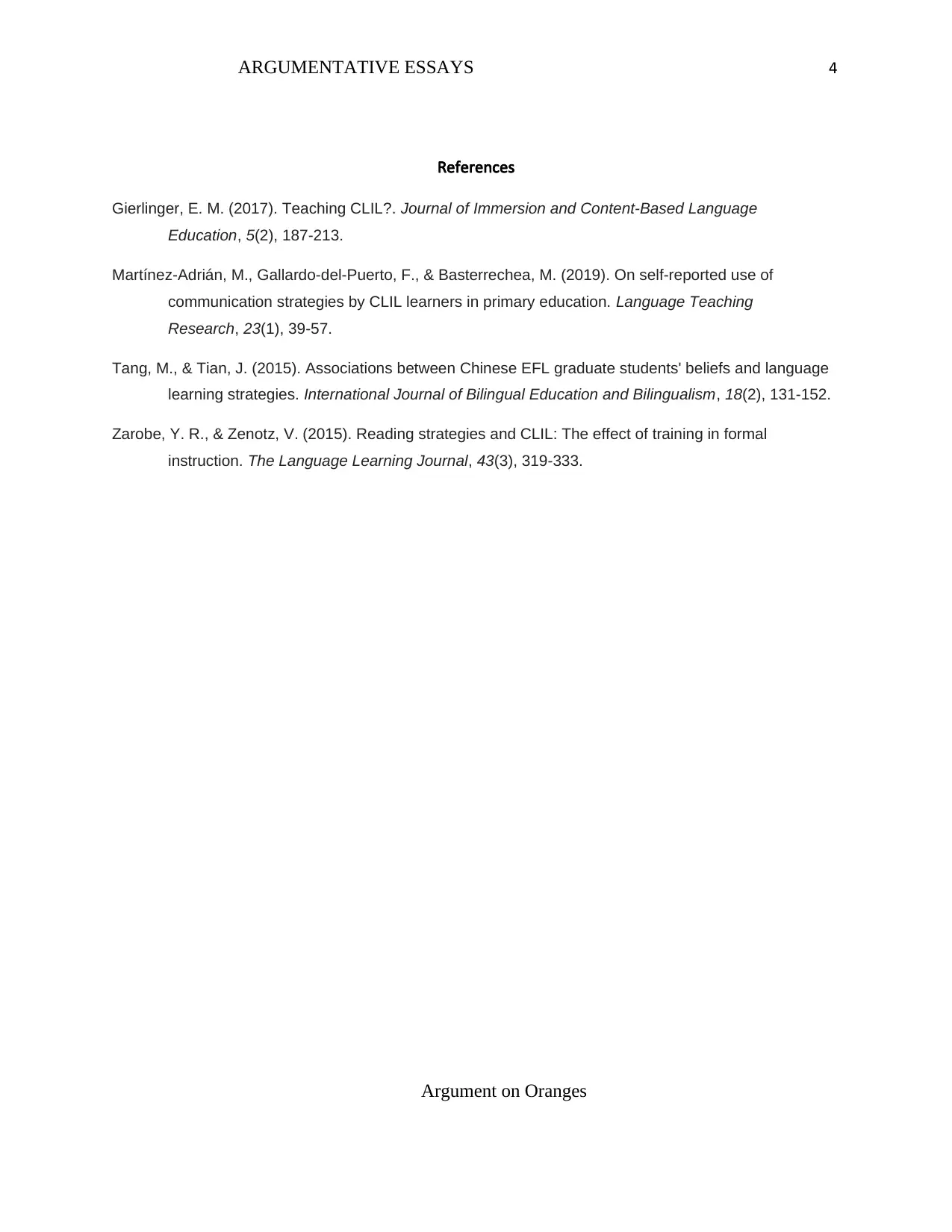
ARGUMENTATIVE ESSAYS 4
References
Gierlinger, E. M. (2017). Teaching CLIL?. Journal of Immersion and Content-Based Language
Education, 5(2), 187-213.
Martínez-Adrián, M., Gallardo-del-Puerto, F., & Basterrechea, M. (2019). On self-reported use of
communication strategies by CLIL learners in primary education. Language Teaching
Research, 23(1), 39-57.
Tang, M., & Tian, J. (2015). Associations between Chinese EFL graduate students' beliefs and language
learning strategies. International Journal of Bilingual Education and Bilingualism, 18(2), 131-152.
Zarobe, Y. R., & Zenotz, V. (2015). Reading strategies and CLIL: The effect of training in formal
instruction. The Language Learning Journal, 43(3), 319-333.
Argument on Oranges
References
Gierlinger, E. M. (2017). Teaching CLIL?. Journal of Immersion and Content-Based Language
Education, 5(2), 187-213.
Martínez-Adrián, M., Gallardo-del-Puerto, F., & Basterrechea, M. (2019). On self-reported use of
communication strategies by CLIL learners in primary education. Language Teaching
Research, 23(1), 39-57.
Tang, M., & Tian, J. (2015). Associations between Chinese EFL graduate students' beliefs and language
learning strategies. International Journal of Bilingual Education and Bilingualism, 18(2), 131-152.
Zarobe, Y. R., & Zenotz, V. (2015). Reading strategies and CLIL: The effect of training in formal
instruction. The Language Learning Journal, 43(3), 319-333.
Argument on Oranges
Paraphrase This Document
Need a fresh take? Get an instant paraphrase of this document with our AI Paraphraser
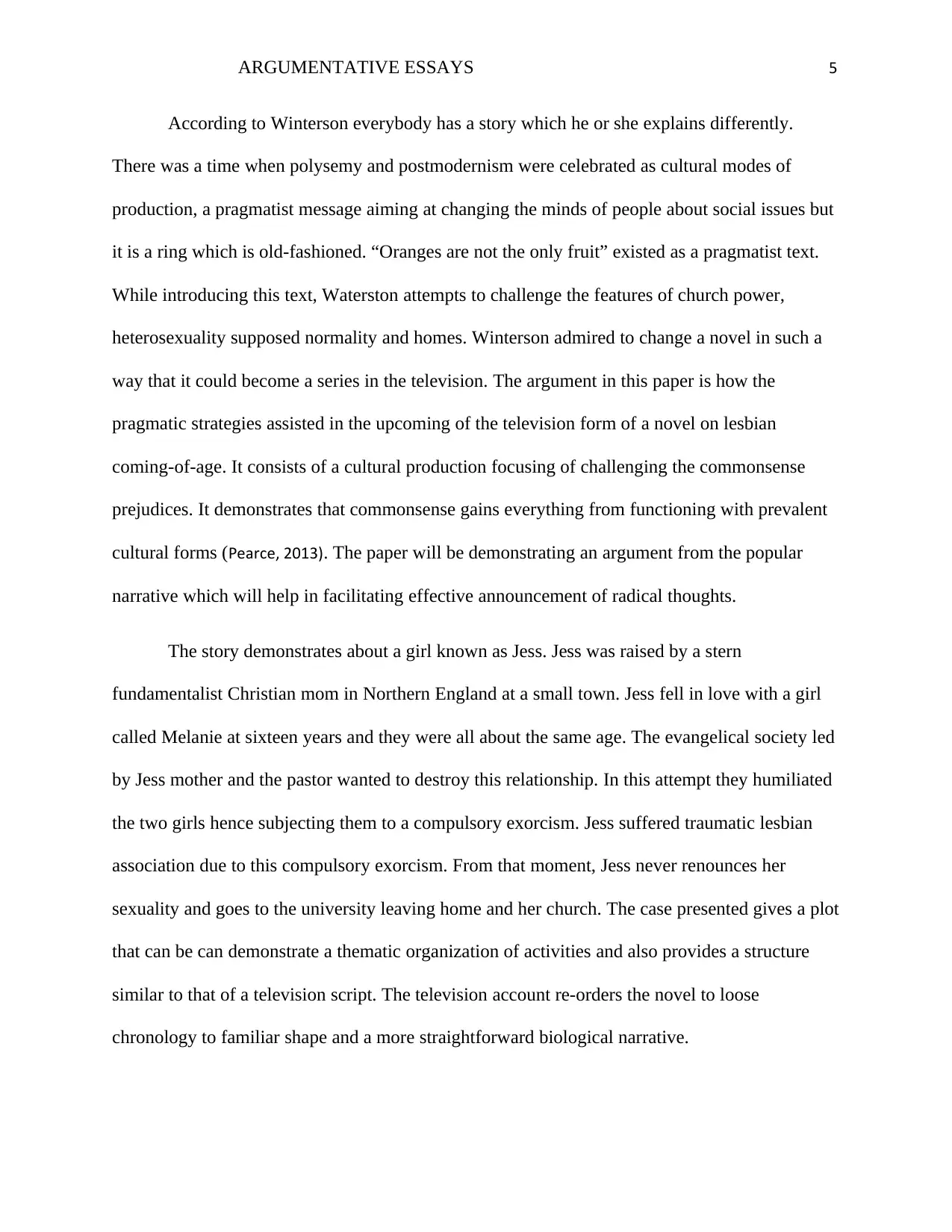
ARGUMENTATIVE ESSAYS 5
According to Winterson everybody has a story which he or she explains differently.
There was a time when polysemy and postmodernism were celebrated as cultural modes of
production, a pragmatist message aiming at changing the minds of people about social issues but
it is a ring which is old-fashioned. “Oranges are not the only fruit” existed as a pragmatist text.
While introducing this text, Waterston attempts to challenge the features of church power,
heterosexuality supposed normality and homes. Winterson admired to change a novel in such a
way that it could become a series in the television. The argument in this paper is how the
pragmatic strategies assisted in the upcoming of the television form of a novel on lesbian
coming-of-age. It consists of a cultural production focusing of challenging the commonsense
prejudices. It demonstrates that commonsense gains everything from functioning with prevalent
cultural forms (Pearce, 2013). The paper will be demonstrating an argument from the popular
narrative which will help in facilitating effective announcement of radical thoughts.
The story demonstrates about a girl known as Jess. Jess was raised by a stern
fundamentalist Christian mom in Northern England at a small town. Jess fell in love with a girl
called Melanie at sixteen years and they were all about the same age. The evangelical society led
by Jess mother and the pastor wanted to destroy this relationship. In this attempt they humiliated
the two girls hence subjecting them to a compulsory exorcism. Jess suffered traumatic lesbian
association due to this compulsory exorcism. From that moment, Jess never renounces her
sexuality and goes to the university leaving home and her church. The case presented gives a plot
that can be can demonstrate a thematic organization of activities and also provides a structure
similar to that of a television script. The television account re-orders the novel to loose
chronology to familiar shape and a more straightforward biological narrative.
According to Winterson everybody has a story which he or she explains differently.
There was a time when polysemy and postmodernism were celebrated as cultural modes of
production, a pragmatist message aiming at changing the minds of people about social issues but
it is a ring which is old-fashioned. “Oranges are not the only fruit” existed as a pragmatist text.
While introducing this text, Waterston attempts to challenge the features of church power,
heterosexuality supposed normality and homes. Winterson admired to change a novel in such a
way that it could become a series in the television. The argument in this paper is how the
pragmatic strategies assisted in the upcoming of the television form of a novel on lesbian
coming-of-age. It consists of a cultural production focusing of challenging the commonsense
prejudices. It demonstrates that commonsense gains everything from functioning with prevalent
cultural forms (Pearce, 2013). The paper will be demonstrating an argument from the popular
narrative which will help in facilitating effective announcement of radical thoughts.
The story demonstrates about a girl known as Jess. Jess was raised by a stern
fundamentalist Christian mom in Northern England at a small town. Jess fell in love with a girl
called Melanie at sixteen years and they were all about the same age. The evangelical society led
by Jess mother and the pastor wanted to destroy this relationship. In this attempt they humiliated
the two girls hence subjecting them to a compulsory exorcism. Jess suffered traumatic lesbian
association due to this compulsory exorcism. From that moment, Jess never renounces her
sexuality and goes to the university leaving home and her church. The case presented gives a plot
that can be can demonstrate a thematic organization of activities and also provides a structure
similar to that of a television script. The television account re-orders the novel to loose
chronology to familiar shape and a more straightforward biological narrative.
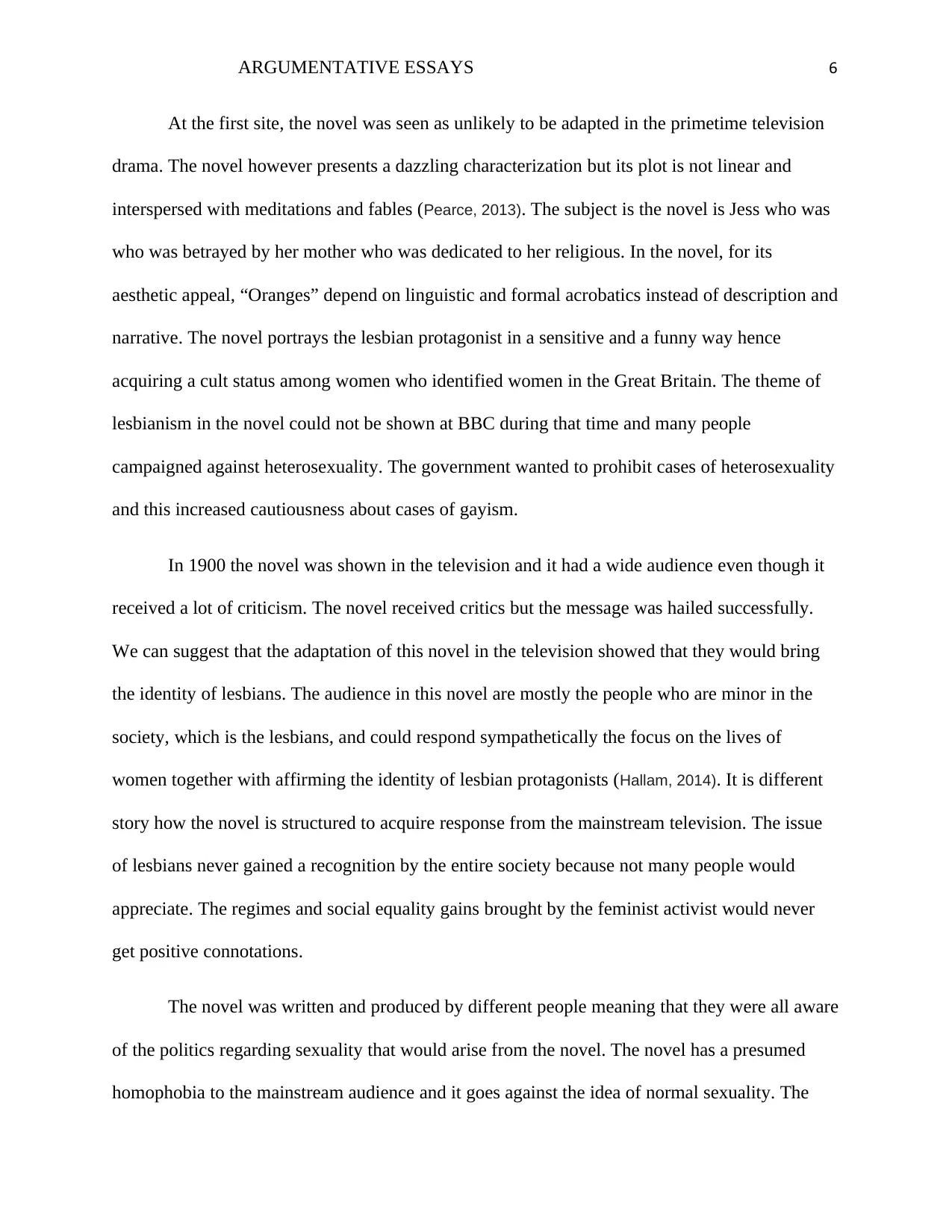
ARGUMENTATIVE ESSAYS 6
At the first site, the novel was seen as unlikely to be adapted in the primetime television
drama. The novel however presents a dazzling characterization but its plot is not linear and
interspersed with meditations and fables (Pearce, 2013). The subject is the novel is Jess who was
who was betrayed by her mother who was dedicated to her religious. In the novel, for its
aesthetic appeal, “Oranges” depend on linguistic and formal acrobatics instead of description and
narrative. The novel portrays the lesbian protagonist in a sensitive and a funny way hence
acquiring a cult status among women who identified women in the Great Britain. The theme of
lesbianism in the novel could not be shown at BBC during that time and many people
campaigned against heterosexuality. The government wanted to prohibit cases of heterosexuality
and this increased cautiousness about cases of gayism.
In 1900 the novel was shown in the television and it had a wide audience even though it
received a lot of criticism. The novel received critics but the message was hailed successfully.
We can suggest that the adaptation of this novel in the television showed that they would bring
the identity of lesbians. The audience in this novel are mostly the people who are minor in the
society, which is the lesbians, and could respond sympathetically the focus on the lives of
women together with affirming the identity of lesbian protagonists (Hallam, 2014). It is different
story how the novel is structured to acquire response from the mainstream television. The issue
of lesbians never gained a recognition by the entire society because not many people would
appreciate. The regimes and social equality gains brought by the feminist activist would never
get positive connotations.
The novel was written and produced by different people meaning that they were all aware
of the politics regarding sexuality that would arise from the novel. The novel has a presumed
homophobia to the mainstream audience and it goes against the idea of normal sexuality. The
At the first site, the novel was seen as unlikely to be adapted in the primetime television
drama. The novel however presents a dazzling characterization but its plot is not linear and
interspersed with meditations and fables (Pearce, 2013). The subject is the novel is Jess who was
who was betrayed by her mother who was dedicated to her religious. In the novel, for its
aesthetic appeal, “Oranges” depend on linguistic and formal acrobatics instead of description and
narrative. The novel portrays the lesbian protagonist in a sensitive and a funny way hence
acquiring a cult status among women who identified women in the Great Britain. The theme of
lesbianism in the novel could not be shown at BBC during that time and many people
campaigned against heterosexuality. The government wanted to prohibit cases of heterosexuality
and this increased cautiousness about cases of gayism.
In 1900 the novel was shown in the television and it had a wide audience even though it
received a lot of criticism. The novel received critics but the message was hailed successfully.
We can suggest that the adaptation of this novel in the television showed that they would bring
the identity of lesbians. The audience in this novel are mostly the people who are minor in the
society, which is the lesbians, and could respond sympathetically the focus on the lives of
women together with affirming the identity of lesbian protagonists (Hallam, 2014). It is different
story how the novel is structured to acquire response from the mainstream television. The issue
of lesbians never gained a recognition by the entire society because not many people would
appreciate. The regimes and social equality gains brought by the feminist activist would never
get positive connotations.
The novel was written and produced by different people meaning that they were all aware
of the politics regarding sexuality that would arise from the novel. The novel has a presumed
homophobia to the mainstream audience and it goes against the idea of normal sexuality. The
⊘ This is a preview!⊘
Do you want full access?
Subscribe today to unlock all pages.

Trusted by 1+ million students worldwide
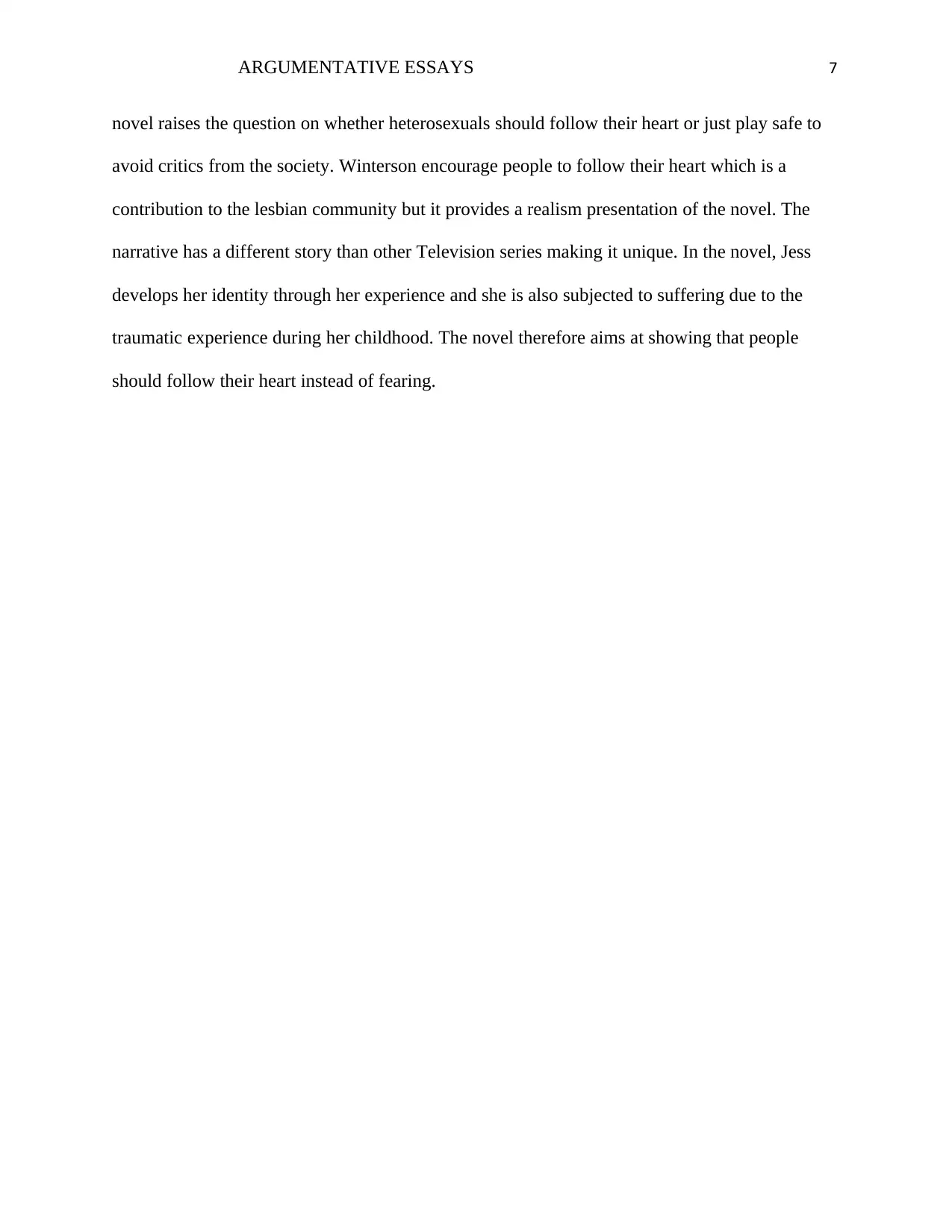
ARGUMENTATIVE ESSAYS 7
novel raises the question on whether heterosexuals should follow their heart or just play safe to
avoid critics from the society. Winterson encourage people to follow their heart which is a
contribution to the lesbian community but it provides a realism presentation of the novel. The
narrative has a different story than other Television series making it unique. In the novel, Jess
develops her identity through her experience and she is also subjected to suffering due to the
traumatic experience during her childhood. The novel therefore aims at showing that people
should follow their heart instead of fearing.
novel raises the question on whether heterosexuals should follow their heart or just play safe to
avoid critics from the society. Winterson encourage people to follow their heart which is a
contribution to the lesbian community but it provides a realism presentation of the novel. The
narrative has a different story than other Television series making it unique. In the novel, Jess
develops her identity through her experience and she is also subjected to suffering due to the
traumatic experience during her childhood. The novel therefore aims at showing that people
should follow their heart instead of fearing.
Paraphrase This Document
Need a fresh take? Get an instant paraphrase of this document with our AI Paraphraser
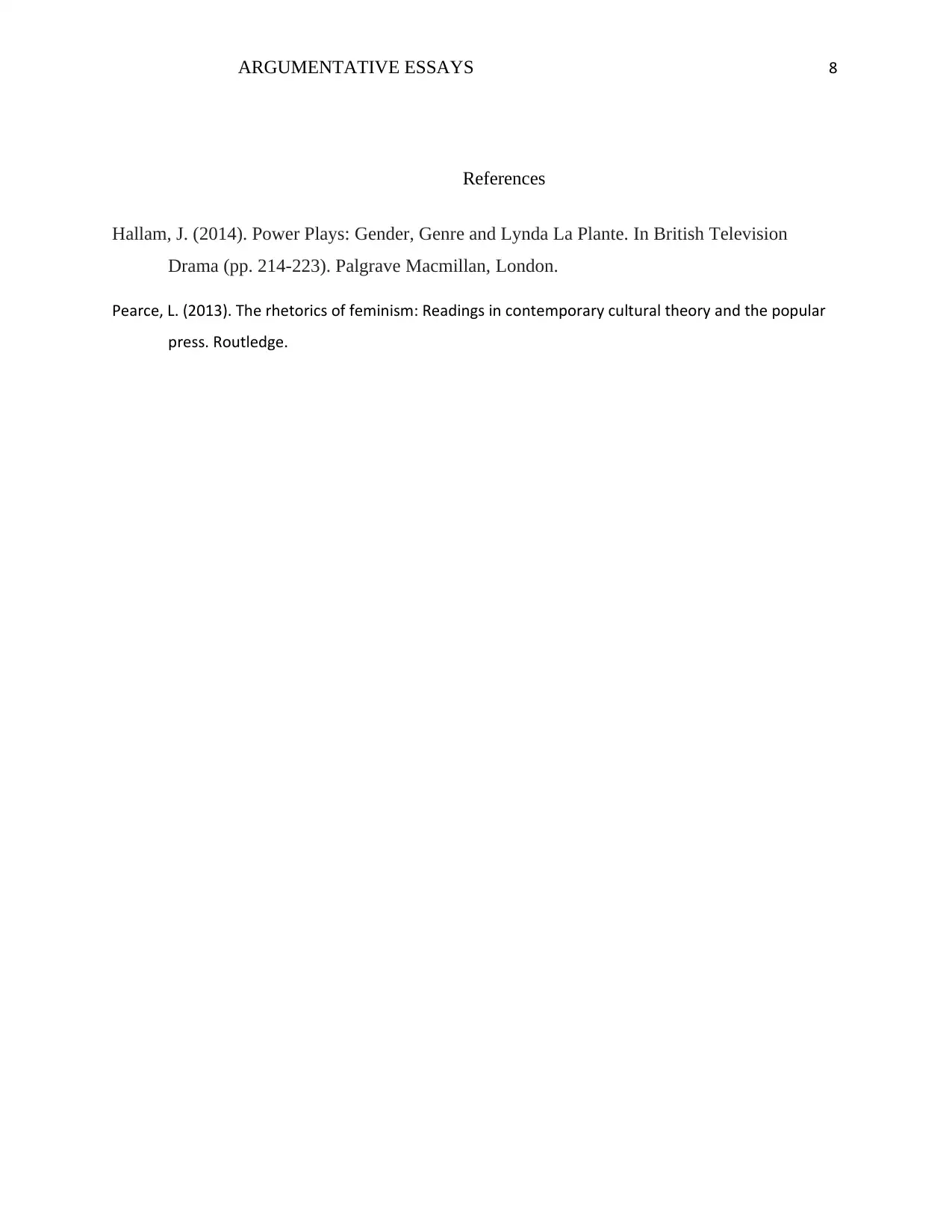
ARGUMENTATIVE ESSAYS 8
References
Hallam, J. (2014). Power Plays: Gender, Genre and Lynda La Plante. In British Television
Drama (pp. 214-223). Palgrave Macmillan, London.
Pearce, L. (2013). The rhetorics of feminism: Readings in contemporary cultural theory and the popular
press. Routledge.
References
Hallam, J. (2014). Power Plays: Gender, Genre and Lynda La Plante. In British Television
Drama (pp. 214-223). Palgrave Macmillan, London.
Pearce, L. (2013). The rhetorics of feminism: Readings in contemporary cultural theory and the popular
press. Routledge.
1 out of 8
Related Documents
Your All-in-One AI-Powered Toolkit for Academic Success.
+13062052269
info@desklib.com
Available 24*7 on WhatsApp / Email
![[object Object]](/_next/static/media/star-bottom.7253800d.svg)
Unlock your academic potential
Copyright © 2020–2025 A2Z Services. All Rights Reserved. Developed and managed by ZUCOL.





